I wanted to provide an update on the membership of the Regular Season Hall of Fame (RSHOF). Immediately, I ran into a problem. Since writing the original article I had updated the way Value Rating (VR) is calculated, a key statistic used in determining a player’s eligibility. I had no real option but to recalculate the “historic” RSHOF calculations.
Since I was playing with the old process, I made a couple of other changes. When I had finished, four players who had not qualified using the first process became members of the RSHOF using the new process, while one player who had qualified was now on the outside looking in (sorry about that, P.K.).
Identifying Members
I wanted to use player statistics to identify players whose careers were exceptionally good as this is to be a Hall of Fame, not a Hall of Pretty Good. Based solely on a perception of their play, the RSHOF should include players like Sidney Crosby and Erik Karlsson but exclude players like Phil Kessel and Jordan Staal.
I needed guidance to determine which statistics should be used to differentiate Sidney and Erik from Phil and Jordan. That guidance came from the guy who got me interested in sports statistics when I was a young man: Bill James. Mr. James does not know me from Adam, by the way.
The Phaneuf List
I have borrowed many ideas from Bill James, the author of the annual Bill James Baseball Abstract (late 1970s through the 1980s). Mr. James did quite a lot of writing about the Baseball Hall of Fame (at least one book on the topic), and he developed a formula that took a player’s career accomplishments, converted them to a number, and used that number to determine whether that player should have been voted into the Hall of Fame.
In an article in the 1985 Abstract, he produced a series of questions one could ask about a player which would guide one’s thoughts on whether he should be voted into the Hall of Fame. He called it the Keltner List, as the article was about people trying to get Ken Keltner into the Hall of Fame.
In my original RSHOF article, I borrowed the Keltner list and modified the questions to reflect hockey. I called it the Osgoode list, as Chris Osgoode’s potential candidacy for the Hall of Fame was a topic of discussion a few years earlier.
In this update to the RSHOF, I have further winnowed the questions on the list and named it after a more recently retired skater: Dion Phaneuf. Goalies are not eligible for the RSHOF, so naming the list after a goalie was a poor idea.

Each question can be answered using statistics (some slight re-phrasing is necessary). Formulas convert statistics into points (RSHOF-Pts), and a player’s total score (the sum of all RSHOF-Pts) is used to determine if he qualified for the RSHOF.
Was he ever regarded as the best player in hockey? I will rephrase that question to “What is the highest value a player had?” Value is measured by Value Rating (VR-Score, specifically): players will receive points for their career maximum VR-Score.
Was he the best player in his position? I look at this as a season-level question, more like “How many seasons was a player one of the best at his position?” This is measured by Productivity Rating (PR-Score, specifically). Players receive points based on the number of times they were in the top 12 forwards or top 8 defensemen.
How many MVP-type seasons did he have? Value is based on Value Rating (in this case, VR-Category). Players receive points based on the number of VR-Elite and VR-Star seasons they have had.
How many All-Star-type seasons did he have? All-Stars are the best players in a season, which is measured by Productivity Rating (PR-Category). Players receive points based on the number of PR-Elite and PR-Star seasons they have had. Players also receive points based on the number of seasons their PR-Score put them in the top 40.
Was he good enough to play regularly after his prime? Another way of phrasing this question is: was he a good player when he was old? Players receive points based on the number of seasons they had where they were at least 30 years old and were PR-Regular or better.
Do the player’s numbers meet Hall of Fame standards? This question is interpreted as does the sum of a player’s career accomplishments meet the minimum standard required for induction to the RSHOF? A player becomes a member when his total RSHOF-Pts is greater than or equal to 400.
Limitations
2007-08 is the start of what I call the rich-statistic era, while seasons before that are in the low-statistic era. Only players who played in the rich-statistic era can be evaluated. This means that players like Bobby Orr and Guy Lafleur will not be included in the RSHOF.
Players whose career spans both eras can only be evaluated for their rich-statistic era seasons. Dion Phaneuf and Andrei Markov are two examples. There is a reason the list of questions is called the Phaneuf list; it could also have been called the Markov list, or even the Chelios list.
Naturalstattrick.com has goalie data, but I do not do much with goalie data. As a result, goalies won’t be considered for the RSHOF.
Naturalstattrick.com has playoff data, but I have never done anything with playoff data and I am not going to start using it for this project. The institution is called the “Regular Season Hall of Fame” for a very good reason.
Regular Season Hall of Fame – In and Out
Let’s look at the statistics of two players, only one of whom is in the RSHOF. The player who qualified is Dustin Byfuglien and the outsider is Dion Phaneuf.
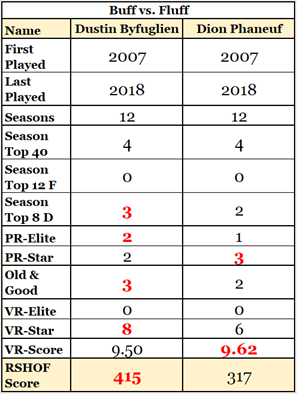
The Buff vs. Fluff table shows the RSHOF statistics. Where the players differ in a category, the higher value is presented in bold red font.
It is very nice that these two players were exact contemporaries, playing the same number of seasons and starting and ending their careers at the same time.
In the rich-statistic era, Byfuglien had one more season where he was a top-eight defenseman, one more PR-Elite season, one more season where he was “good and old”, and two more VR-Star seasons.
Phaneuf had one more PR-Star season, and his best VR-Score was slightly higher.
The criterion for inclusion in the RSHOF is to have an RSHOF score of 400 or more. Byfuglien just made it, Phaneuf missed.
Both players played two seasons before the rich-statistic era: their careers began in the 2005-06 season. Phaneuf’s two low-statistic seasons were great, and if we had the necessary statistics from those seasons, he would be in the RSHOF. But we do not have those statistics, so he is not in the RSHOF.
By way of consolation to Phaneuf, a list of questions was named after him.
RSHOF Score Calculations – Generally and Specifically
I would usually include a section that provides a detailed description of the calculations, but I decided against going into detail for this article. The reason I’m not going into details is that the process uses fractional exponents.
At the high level, each statistic generates points (RSHOF-Pts) based on its value, weight, and exponent for the value. The weight is used to make more important categories provide a bigger score, and the exponent is used to reward longer careers.
The exponent is based on career length: the exponent is 1.0 plus 0.1 for each year played to a maximum of 2.0. I fear I may have lost a few people with that last sentence. Let me give you one example of how this exponent stuff works on one of the qualifying statistics, using a fictitious player named T’von Daves. In his five-season career, he has been a top-eight defenseman three times. The category weight for the top-eight defenseman category is 3, and his exponent value will be 1.5 (1.0 + (5*0.1)).

If his career continues for another five seasons, and he never again is a top-eight defenseman, he will get more value for his early accomplishments.

Inductees, Season by Season
In the next sections, the players who have qualified for the RSHOF will be introduced in order of the seasons in which they qualified.
While these sections use wording that indicates that the players were inducted in the past, that’s obviously not true. It’s just simpler to say, “Alex Ovechkin qualified for the RSFOH” than “Alex Ovechkin would have qualified for the RSHOF, had these calculations been done after the 2014-15 season.”
The table below shows all current members of the Regular Season Hall of Fame, including this year’s new members.
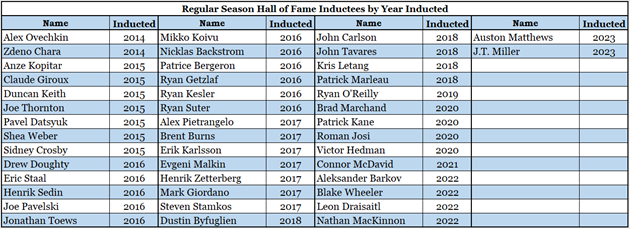
2014-15 Inductees
After only eight seasons of play in the rich-statistic era, the first two players to qualify for the RSHOF were Alex Ovechkin and Zdeno Chara.
In those eight seasons, Chara was a top-8 defenseman five times, he had had three PR-Elite and four PR-Star seasons, and he had had one VR-Elite and six VR-Star seasons. In all eight seasons, Chara was considered “old and good.”
Ovechkin was a top-12 forward in the league six times, he had had three PR-Elite and four PR-Star seasons, and he had had three VR-Elite and four VR-Star seasons. Ovechkin was not yet old enough to be considered “old and good”.
Both players played before the rich-statistic era, and none of those seasons were included.
2015-16 Inductees
Seven players entered the RSHOF after the 2015-16 season. Alphabetically (by first name) they were: Anze Kopitar, Claude Giroux, Duncan Keith, Joe Thornton, Pavel Datsyuk, Shea Weber, and Sidney Crosby.
The NHL tends to induct a set number of people into the real Hall of Fame every season. The biggest problem with that approach is that it needlessly delays the induction of deserving people. At Stapled to the Bench, players are inducted into the RSHOF when they qualify, whether one player qualifies, or seven, or eleven.
The NHL waits until several years after a player’s career has ended before allowing a player to be inducted. As RSHOF qualification is based on regular season statistics, all players who are inducted were playing the season of their induction. Why wait? It is impossible for a player’s RSHOF score to ever go down.
Sidney Crosby needed one “extra” year to qualify because injuries reduced his play in three seasons. He missed 99 games in 2010-11 and 2011-12 and then missed a quarter of the games in the lockout season of 2012-13. You may not remember, but at the time there was concern that he’d never play again. Because he missed so much playing time in those three seasons, he didn’t get the PR-Elite ratings he almost certainly would have had, so his total RSHOF score was below 400 after the 2014-15 season.
2016-17 Inductees
Eleven players were inducted in 2016-17: Drew Doughty, Eric Staal, Henrik Sedin, Joe Pavelski, Jonathan Toews, Mikko Koivu, Nicklas Backstrom, Patrice Bergeron, Ryan Getzlaf, Ryan Kesler, Ryan Suter. It was a good year for players named Ryan.
2017-18 Inductees
A more manageable seven players qualified after the 2017-18 season: Alex Pietrangelo, Brent Burns, Erik Karlsson, Evgeni Malkin, Henrik Zetterberg, Mark Giordano, Steven Stamkos.
The reason for the large number of players being inducted from 2015-16 to 2017-18 is related to the start of the rich statistics era. Several of the players inducted in these last three seasons had careers that spanned back into the low-statistic era. Many of them would have qualified earlier in their careers had the rich-statistic era started earlier.
2018-19 Inductees
Five players qualified after 2018-19: Dustin Byfuglien, John Carlson, John Tavares, Kris Letang, and Patrick Marleau.
Many people were surprised by Byfuglien’s abrupt retirement after this season. A look at his career Productivity chart shows how his productivity decreased due to his injuries, while his career Value chart shows the level of value he maintained. Eight VR-Star seasons are nothing to sneeze at.
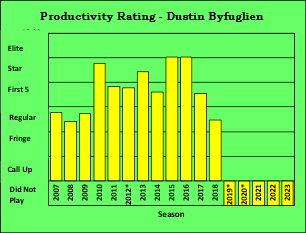
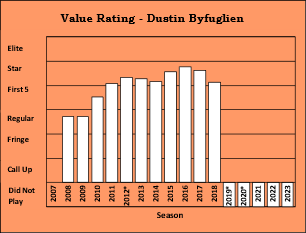
It is extremely unfortunate that injuries curtailed Byfuglien’s extremely promising career. Actually, it is extremely unfortunate when any player’s career is shortened due to injuries.
2019-20 Inductee
Only one player qualified for induction in 2019-20: Ryan O’Reilly.
As mentioned earlier, players are inducted immediately upon qualifying. If no players qualify, nobody is inducted. There are no participation ribbons in the RSHOF, no honorary members, and no coaches. Well, okay, I suppose coaches could be in the RSHOF, but only if they had qualified as players.
2020-21 Inductees
An interesting quartet qualified for induction following the 2020-21 season: Brad Marchand, Patrick Kane, Roman Josi, and Victor Hedman. Three seemingly nice people and Brad Marchand. Three players who played for teams I don’t mind and Brad Marchand. Three people I’ve never seen in person and Brad Marchand (who was having dinner at a table next to me in a restaurant in Kanata).
This is yet another good reason for RSHOF induction to be strictly a matter of formulas. Whether I like a player is irrelevant, whether he plays for a team I dislike is irrelevant. The only relevant question is: do his numbers merit his inclusion in the RSHOF?
At the end of 2020-21, Marchand had been a top-40 player in the league four times, a top-12 forward three times, and he had had two PR-Elite seasons, three PR-Star seasons, and four VR-Star seasons. He also had two “old and good” seasons.
2021-22 Inductee
The lone 2021-22 inductee is Connor McDavid. McDavid is the only player to have qualified only seven seasons into his career.
He has packed a lot of accomplishments into those seven seasons: six times in the top 40, six times a top-12 forward, five PR-Elite seasons, one PR-Star season, four VR-Elite seasons, and two VR-Star seasons. He has the highest VR-Score of any player.
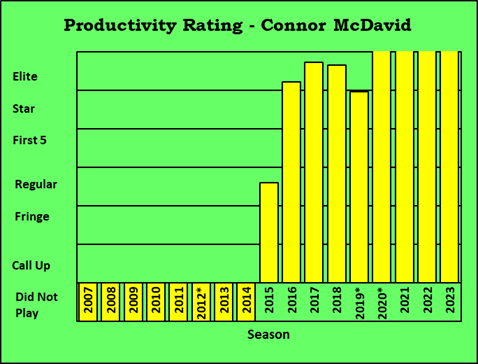
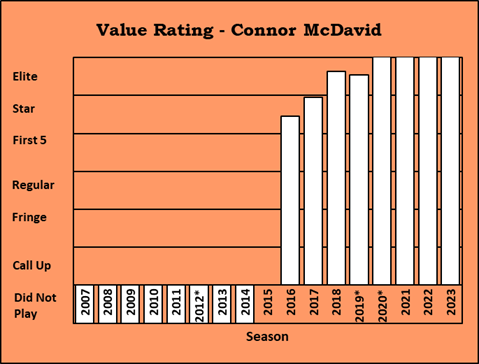
Going back to the Phaneuf list, the first question is: Was he ever regarded as the best player in hockey? Taking that question in its literal sense, McDavid has been regarded as the best player in hockey these last five years.
Before McDavid, only three players have a credible claim to have been considered the best player in hockey: Erik Karlsson, Sidney Crosby, and Alex Ovechkin. Please see the 2023-24 Most Valuable Player article for more details.
2022-23 Inductees
2022-23 produced four RSHOF inductees: Aleksander Barkov, Blake Wheeler, Leon Draisaitl, and Nathan MacKinnon.
Blake Wheeler? Yeah, Blake Wheeler, because fifteen seasons played, top-40 player five times, top-12 forward twice, six PR-Star seasons, five VR-Star seasons, and six “old and good” seasons. At the time of Wheeler’s induction, 43 players had at least six PR-Star seasons and at least five VR-Star seasons: 38 were in the RSHOF, two were still playing and technically had a chance of being inducted, and three were retired leaving them no chance of being inducted.
One of those three retirees is Andrei Markov, and he too is an unfortunate victim of timing with respect to the RSHOF. Markov’s first six seasons came before the rich-statistic era, so his accomplishments in that time frame cannot be considered.
2023-24 Inductees
This year’s inductees are Auston Matthews and J.T. Miller.
Matthews enters the RSHOF after his eighth season, a very impressive feat. 2023-24 was his sixth season as a top-40 player in the league, his fourth as a top-12 forward, his fourth PR-Elite season, and his fourth VR-Elite season. He also has had two PR-Star and three VR-Star seasons.
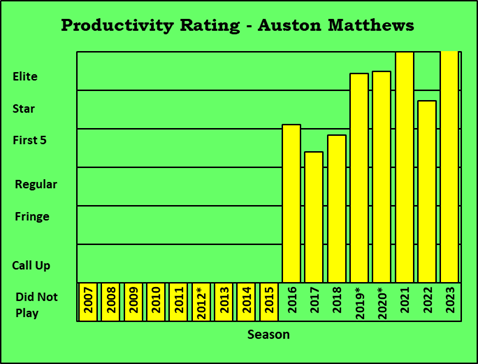
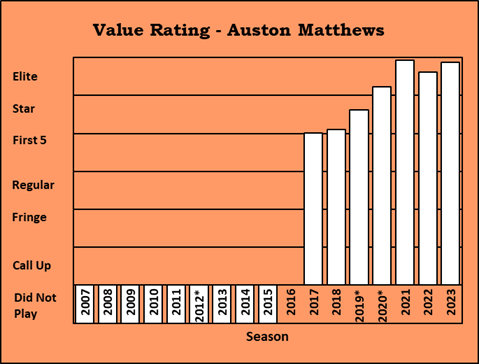
J.T. Miller enters after his twelfth season, a more normal time span. 2023-24 was his fourth season as a top-40 player in the league, his fourth as a top-12 forward, his fourth PR-Elite season, and his first VR-Elite season. He also has had three VR-Star seasons, but no PR-Star seasons. No PR-Star seasons? That raised my curiosity just a bit.
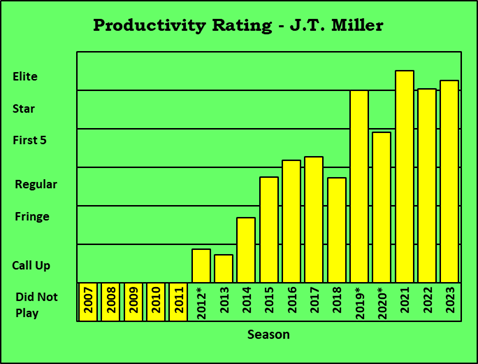
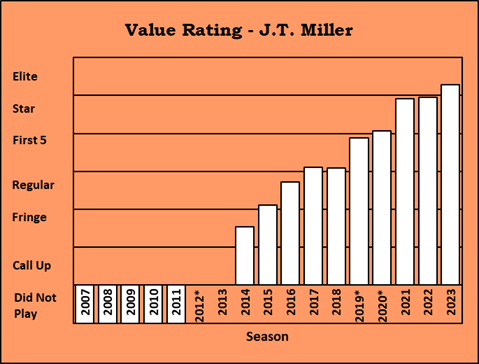
Before 2019-20, J.T. Miller was not on the path to the RSHOF. His first seven seasons are not RSHOF worthy: the only thing he got credited for was having played a season, and those seasons were worth 36 RSHOF-Pts, leaving him 364 RSHOF-Pts short of the RSHOF. Since 2019-20 he has had three PR-Elite seasons, one PR-Star season, three VR-Star seasons, and one VR-Elite season. He also just had his first “good and old” season.
Knocking on Heaven’s Door
Nikita Kucherov, David Pastrnak, and Mikko Rantanen could all gain entry to the RSHOF with one more good top-40-level season.
Seth Jones needs one more very good season. He needs to have a PR-Star season in 2024-25, which will also give him a VR-Star rating, and those two accomplishments would see him into the RSHOF. Coté negative: his PR-Score has been dropping these last two seasons and he is playing for Chicago. Both of those factors reduce the possibility of putting up a PR-star-level season.
Summary
An unfortunate aspect of the RSHOF is that it only considers the statistics of players from the 2007-08 season onwards. Andrei Markov and Dion Phaneuf are two of several players whose earlier seasons would have produced enough statistics to see them included in the RSHOF.
Could an exception be made for Markov and Phaneuf? No, because I want to be fair to all players. If I’m going to make an exception for Markov and Phaneuf, I should make an exception for all other players who didn’t play enough in the rich-statistic era. At this point in my thought process the career of Chris Chelios entered my mind.
Chelios first played with the Montreal Canadiens in the 1983-84 season. To be fair to all players I’d want to include all players from his career span, which involves players whose careers were just ending when Chelios’s career began. Players like Guy Lapointe.
And then I’d have to be fair to guys who played during Lapointe’s career. This regressive inclusion of players would bring me back to 1917-18, the first NHL season. Should Cy Denneny be in the RSHOF?
With apologies to Markov and Phaneuf and all other players who played a significant portion of their careers in the low-statistic era: there will be no exceptions to the rules for inclusion in the RSHOF. If a set of rich statistical data for earlier seasons miraculously appears, I will almost certainly change my mind.
Related Articles
The Regular Season Hall of Fame (original article)
2023-24 Most Valuable Player
